BEKO FSE1073N User Manual [fr]

Refrigerator
Gefrierschrank
Réfrigérateur
Koelkast
FSE 1073 FSE 1073 X FSE 1073 X FSE 1000 FSE 1070 FSE 1072 FSE 1074 FSE 1072 X

Please read this manual first!
Dear Customer,
We hope that your product, which has been produced in modern plants and checked under the most meticulous quality control procedures, will provide you an effective service.
For this, we recommend you to carefully read the entire manual of your product before using it and keep it at hand for future references.
This manual
•Will help you use your appliance in a fast and safe way.
•Read the manual before installing and operating your product.
•Follow the instructions, especially those for safety.
•Keep the manual in an easily accessible place as you may need it later.
•Besides, read also the other documents provided with your product.
Please note that this manual may be valid for other models as well.
Symbols and their descriptions
This instruction manual contains the following symbols:
C Important information or useful usage tips.
AWarning against dangerous conditions for life and property.
BWarning against electric voltage.
This product is supplied with the selective sorting symbol for waste electrical Recycling and electronic equipment (WEEE).
This means that this product must be handled pursuant to European Directive
2002/96/EC in order to be recycled or dismantled to minimise its impact on the environment. For further information, please contact your local or regional authorities.
Electronic products not included in the selective sorting process are potentially dangerous for the environment and human health due to the presence of hazardous substances.
This product was manufactured using the latest technology in environmentally friendly conditions.

CONTENTS
1 Your refrigerator |
3 |
2 Important Safety |
|
Warnings |
4 |
Intended use...................................... |
4 |
For products with a water dispenser;.6 |
|
Child safety........................................ |
6 |
HCA Warning..................................... |
6 |
Things to be done for energy saving... |
7 |
4 |
Preparation |
13 |
5 |
Using your refrigerator |
14 |
Setting the operating temperature....14 LED indicators and control panel......14
6 Maintenance and |
|
cleaning |
18 |
Protection of plastic surfaces ..........18
3 Installation |
8 |
Points to be considered when re- |
|
transporting your refrigerator.............. |
8 |
Before operating your refrigerator....... |
8 |
Electric connection............................. |
9 |
Disposing of the packaging................ |
9 |
Disposing of your old refrigerator........ |
9 |
Placing and Installation....................... |
9 |
Adjusting the feet............................. |
10 |
Reversing the doors......................... |
11 |
Reversing the doors......................... |
12 |
7 Recommended solutions
for the problems |
19 |
2 EN
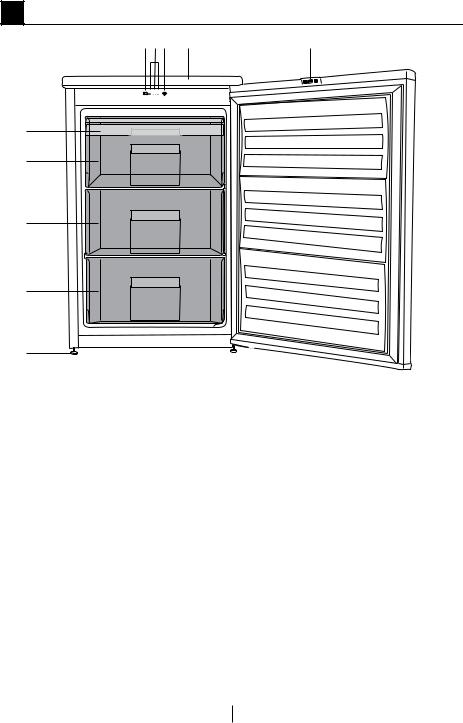
1 Your refrigerator
3 4 5 |
2 |
1 |
6
7
8
8
9
1.Reflectors
2.Top trim
3.Fast-Freeze switch
4.Indicator lights
5.Thermostat knob
6.Ice bank
7.Fast-freeze compartment
8.Frozen-food compartments
9.Adjustable front feet
CFigures that take place in this instruction manual are schematic and may not correspond exactly with your product. If the subject parts are not included in the product you have purchased, then it is valid for other models.
3 EN

2 Important Safety Warnings
Please review the following information. Failure to observe this information may cause injuries or material damage. Otherwise, all warranty and reliability commitments will become invalid.
The usage life of the unit you purchased is 10 years. This is the period for keeping the spare parts required for the unit to operate as described.
Intended use
This product is intended to be used
–indoors and in closed areas such as homes;
–in closed working environments such as stores and offices;
–in closed accommodation areas such as farm houses, hotels, pensions.
•This product should not be used outdoors.
General safety
•When you want to dispose/scrap the product, we recommend you to
consult the authorized service in order to learn the required information and authorized bodies.
•Consult your authorized service for all your questions and problems related to the refrigerator. Do not intervene or let someone intervene to the refrigerator without notifying the authorised services.
•For products with a freezer compartment; Do not eat cone ice cream and ice cubes immediately after you take them out of the freezer compartment! (This may cause frostbite in your mouth.)
•For products with a freezer compartment; Do not put bottled and canned liquid beverages in the freezer compartment. Otherwise, these may burst.
•Do not touch frozen food by hand; they may stick to your hand.
•Unplug your refrigerator before cleaning or defrosting.
•Vapor and vaporized cleaning materials should never be used in cleaning and defrosting processes of your refrigerator. In such cases, the vapor may get in contact with the electrical parts and cause short circuit or electric shock.
•Never use the parts on your refrigerator such as the door as a means of support or step.
•Do not use electrical devices inside the refrigerator.
•Do not damage the parts, where the refrigerant is circulating, with
drilling or cutting tools. The refrigerant that might blow out when the gas channels of the evaporator, pipe extensions or surface coatings are punctured causes skin irritations and eye injuries.
•Do not cover or block the ventilation holes on your refrigerator with any material.
•Electrical devices must be repaired by only authorised persons. Repairs performed by incompetent persons create a risk for the user.
•In case of any failure or during a maintenance or repair work,
disconnect your refrigerator’s mains
4 EN
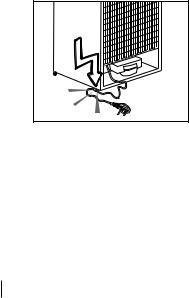
supply by either turning off the relevant fuse or unplugging your appliance.
•Do not pull by the cable when pulling off the plug.
•Place the beverage with higher proofs tightly closed and vertically.
•Never store spray cans containing flammable and explosive substances in the refrigerator.
•Do not use mechanical devices or other means to accelerate the
defrosting process, other than those recommended by the manufacturer.
•This product is not intended to be used by persons with physical, sensory or mental disorders or unlearned or inexperienced people (including children) unless they are attended by a person who will be responsible for their safety or who will instruct them accordingly for use of the product
•Do not operate a damaged refrigerator. Consult with the service agent if you have any concerns.
•Electrical safety of your refrigerator shall be guaranteed only if the earth system in your house complies with standards.
•Exposing the product to rain, snow, sun and wind is dangerous with respect to electrical safety.
•Contact authorized service when there is a power cable damage to avoid danger.
•Never plug the refrigerator into the wall outlet during installation. Otherwise, risk of death or serious injury may arise.
•This refrigerator is intended for only storing food items. It must not be used for any other purpose.
•Label of technical specifications is located on the left wall inside the refrigerator.
•Never connect your refrigerator to electricity-saving systems; they may damage the refrigerator.
•If there is a blue light on the refrigerator, do not look at the blue light with optical tools.
•For manually controlled refrigerators, wait for at least 5 minutes to start the refrigerator after power failure.
•This operation manual should be handed in to the new owner of the product when it is given to others.
•Avoid causing damage on power cable when transporting the refrigerator. Bending cable may cause fire. Never place heavy objects on power cable. Do not touch the plug with wet hands when plugging the product.
•Do not plug the refrigerator if the wall outlet is loose.
•Water should not be sprayed directly on inner or outer parts of the product for safety purposes.
•Do not spray substances containing inflammable gases such as propane
5 EN

gas near the refrigerator to avoid fire and explosion risk.
•Never place containers filled with water on top of the refrigerator, otherwise this may cause electric shock or fire.
•Do not overload your refrigerator with excessive amounts of food. If overloaded, the food items may fall down and hurt you and damage refrigerator when you open the door. Never place objects on top of the refrigerator; otherwise, these objects may fall down when you open or close the refrigerator's door.
•As they require a precise temperature, vaccines, heat-sensitive medicine and scientific materials and etc. should not be kept in the refrigerator.
•If not to be used for a long time, refrigerator should be unplugged. A possible problem in power cable may cause fire.
•The plug's tip should be regularly cleaned; otherwise, it may cause fire.
•The plug’s tip should be cleaned regularly with a dry cloth; otherwise, it may cause fire.
•Refrigerator may move if adjustable legs are not properly secured on the floor. Properly securing adjustable legs on the floor can prevent the refrigerator to move.
•When carrying the refrigerator, do not hold it from door handle. Otherwise, it may be snapped.
•When you have to place your product next to another refrigerator or freezer, the distance between devices should be at least 8cm. Otherwise, adjacent side walls may be humidified.
For products with a water dispenser;
Pressure of water mains should be minimum 1 bar. Pressure of water mains should be maximum 8 bars.
• Use only potable water.
Child safety
•If the door has a lock, the key should be kept away from reach of children.
•Children must be supervised to prevent them from tampering with the product.
HCA Warning
If your product's cooling system contains R600a:
This gas is flammable. Therefore, pay attention to not damaging the cooling system and piping during usage and transportation. In the event of damage, keep your product away from potential fire sources that can cause the product catch a fire and ventilate the room in which the unit is placed.
Ignore this warning if your product's cooling system contains R134a.
Type of gas used in the product is stated in the type plate which is on the left wall inside the refrigerator.
Never throw the product in fire for disposal.
6 EN

Things to be done for energy saving
•Do not leave the doors of your refrigerator open for a long time.
•Do not put hot food or drinks in your refrigerator.
•Do not overload your refrigerator so that the air circulation inside of it is not prevented.
•Do not install your refrigerator under direct sunlight or near heat emitting appliances such as ovens, dishwashers or radiators.
•Pay attention to keep your food in closed containers.
•For products with a freezer compartment; You can store maximum amount of food items in the freezer when you remove the shelf or drawer of the freezer. Energy consumption value stated for your refrigerator has been determined
by removing freezer shelf or drawer and under maximum load. There is no harm to use a shelf or drawer
according to the shapes and size of food to be frozen.
•Thawing frozen food in fridge compartment will both provide energy saving and preserve the food quality.
7 EN
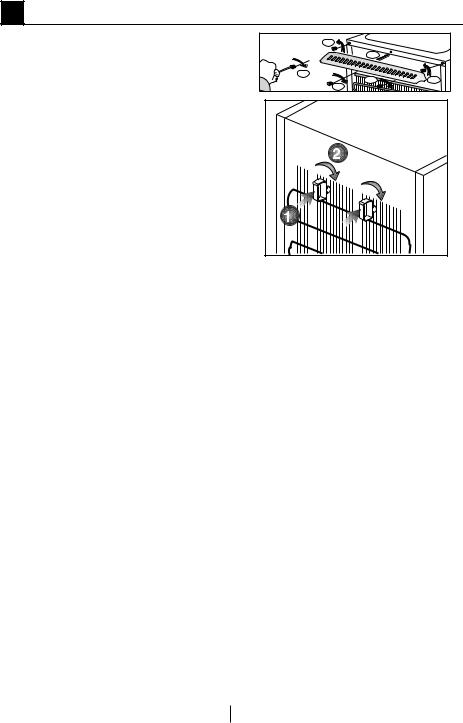
3 Installation
BPlease remember that the manufacturer shall not be held liable if the information given in the instruction manual is not observed.
Points to be considered when re-transporting your refrigerator
1.Your refrigerator must be emptied and cleaned prior to any transportation.
2.Shelves, accessories, crisper and etc. in your refrigerator must be fastened securely by adhesive tape against any jolt before repackaging.
3.Packaging must be tied with thick tapes and strong ropes and the rules of transportation printed on the package must be followed.
Please do not forget… Every recycled material is an
indispensable source for the nature and for our national resources.
If you wish to contribute to recycling the packaging materials, you can get further information from the environmental bodies or local authorities.
Before operating your refrigerator
Before starting to use your refrigerator check the following:
1.Is the interior of the refrigerator dry and can the air circulate freely in the rear of it?
2.Please install the 2 plastic wedges as illustrated in the figure. Plastic wedges will provide the required distance
|
1 |
|
|
|
|
2 |
|
3 |
|
3 |
1 |
|
3 |
||
|
|
|
between your refrigerator and the wall in order to allow the air circulation. (The illustrated figure is only an example and does not match exactly with your product.)
3.Clean the interior of the refrigerator as recommended in the “Maintenance and cleaning” section.
4.Plug the refrigerator into the wall outlet. When the fridge door is open, the fridge compartment interior light will come on.
5.You will hear a noise as the compressor starts up. The liquid and gases sealed within the refrigeration system may also give rise to noise, even if the compressor is not running and this is quite normal.
6.Front edges of the refrigerator may feel warm. This is normal. These areas are designed to be warm to avoid condensation
8 EN

Electric connection
Connect your product to a grounded socket which is being protected by a fuse with the appropriate capacity.
Important:
•The connection must be in compliance with national regulations.
•The power cable plug must be easily accessible after installation.
•The specified voltage must be equal to your mains voltage.
•Extension cables and multiway plugs must not be used for connection.
BA damaged power cable must be replaced by a qualified electrician.
BProduct must not be operated before it is repaired! There is danger of electric shock!
Disposing of the packaging
The packing materials may be dangerous for children. Keep the packing materials out of the reach of children or dispose of them by classifying them in accordance with the waste instructions. Do not dispose of them along with the normal household waste.
The packing of your refrigerator is produced from recyclable materials.
Disposing of your old refrigerator
Dispose of your old refrigerator without giving any harm to the environment.
•You may consult your authorised dealer or waste collection center of your municipality about the disposal of your refrigerator.
Before disposing of your refrigerator, cut out the electric plug and, if there are any locks on the door, make them inoperable in order to protect children against any danger.
Placing and Installation
AIf the entrance door of the room where the refrigerator will be installed is not wide enough for the refrigerator to pass through, then call the authorised service to have them remove the doors of your refrigerator and pass it sideways through the door.
1.Install your refrigerator to a place that allows ease of use.
2.Keep your refrigerator away from heat sources, humid places and direct sunlight.
3.There must be appropriate air ventilation around your refrigerator in order to achieve an efficient operation. If the refrigerator is to be placed in a recess in the wall, there must be at least 5 cm distance with the ceiling and at least 5 cm with the wall. If the floor is covered with a carpet, your product must be elevated 2.5 cm from the floor.
4.Place your refrigerator on an even floor surface to prevent jolts.
5.Do not keep your refrigerator in ambient temperatures under 10°C.
9 EN

Adjusting the feet
If your refrigerator is unbalanced;
You can balance your refrigerator by turning the front legs as shown in the illustration below. The corner where the leg exists is lowered when you turn it in the direction of black arrow and raised when you turn in the opposite direction. Taking help from someone to slightly lift the refrigerator will facilitate this process.
10 EN
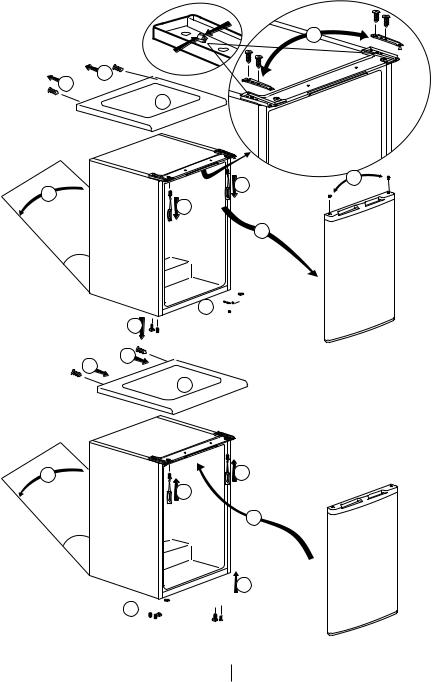
Reversing the doors
Proceed in numerical order
9
7
7
 8
8
5
6
1
6
4
60°
3

2
12
12
 10
10
14 |
11 |
|
|
|
11 |
|
13 |
|
60° |
 16
16
15

11 EN

Reversing the doors
Proceed in numerical order
|
a |
a |
c |
|
b |
d |
b |
|
|
e |
840 mm |
820 mm |
2
1
595 mm
55 mm |
3

 b b
b b 
4
12 EN

4 Preparation
CYour refrigerator should be installed at least 30 cm away from heat sources such as hobs, ovens, central heater and stoves and at least 5 cm away from electrical ovens and should not be located under direct sunlight.
CThe ambient temperature of the room where you install your
refrigerator should at least be 10°C. Operating your refrigerator under cooler conditions than this is not recommended with regard to its efficiency.
CPlease make sure that the interior of your refrigerator is cleaned thoroughly.
CIf two refrigerators are to be installed side by side, there should be at least 2 cm distance between them.
CWhen you operate your refrigerator for the first time, please observe the following instructions during the initial six hours.
-The door should not be opened frequently.
-It must be operated empty without any food in it.
-Do not unplug your refrigerator. If a power failure occurs out of your control, please see the warnings in the “Recommended solutions for the problems” section.
COriginal packaging and foam materials should be kept for future transportations or moving.
13 EN
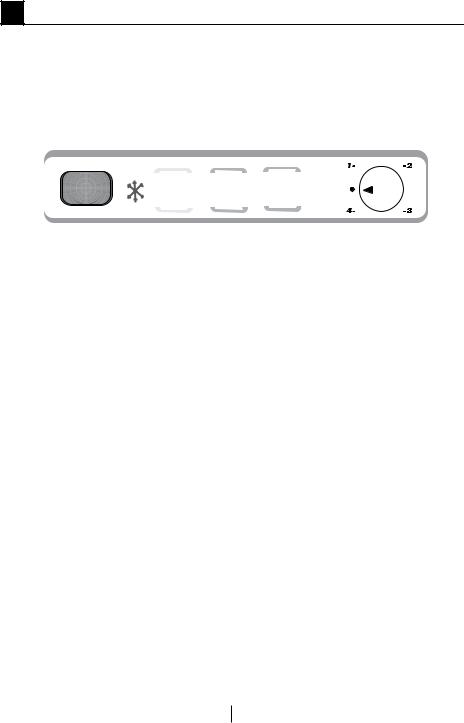
5 Using your refrigerator
Setting the operating temperature
4 |
2 |
3 |
1 |
5 |
|
|
|
|
|
|
|
|
|
|
|
|
|
|
|
|
|
|
|
|
|
|
|
|
|
|
|
|
|
|
|
LED indicators and control panel
There are three coloured indicator lights located on the front of the appliance which shows the operating mode of the freezer.
Green Indicator (1): Illuminates when the appliance is connected to the mains and will glow as long as electricity is available. The green light will not glow if the thermostat is set to ‘0’ position. The green indicator does not give any indication of the temperature inside the freezer.
Amber Indicator (2): This indicator will glow when the fast freeze switch is on and will continue to glow until the fast freeze switch is turned off. The compressor will run continuously while fast freeze switch is on. Fast freeze operation is for freezing fresh food.
Red Indicator (3) Illuminates:
a) If the pre-set temperature can not be maintained.
b) If excessive amounts of fresh food are placed inside.
c) If the appliance door is left open accidentally.
Thermostat knob (5) Thermostat knob is located on the indicator light set.
IMPORTANT: When you press the fast freeze switch, there may be a short delay before the compressor starts to operate. This is normal and does not indicate a compressor fault.
14 EN

The operating temperature is regulated by the temperature control.
Warm 





 Cold
Cold
1 = Lowest cooling setting (Warmest setting)
4 = Highest cooling setting (Coldest setting)
(Or)
Min. = Lowest cooling setting (Warmest setting)
Max. = Highest cooling setting (Coldest setting)
Please choose the setting according to the desired temperature.
The interior temperature also depends on ambient temperature, the frequency with which the door is opened and the amount of food kept inside.
Frequently opening the door causes the interior temperature to rise.
For this reason, it is recommended to close the door again as soon as possible after use.
The normal storage temperature of your appliance should be -18 °C (0 °F). If the thermostat knob is turned counter clockwise from position 1, the appliance will be switched off and “click” sound will be heard. Lower temperatures can
be obtained by adjusting the thermostat knob towards Position 4.
We recommend checking the temperature with a thermometer to ensure that the storage compartments are kept to the desired temperature.
Remember at take the reading immediately since the thermometer temperature will rise very rapidly after you remove it from the freezer.
Freezing food
The freezing area is marked with  symbol on the door liner.
symbol on the door liner.
You can use the appliance for freezing fresh food as well as for storing prefrozen food.
Please refer to the recommendations given on the packaging of your food.
A Attention
Do not freeze fizzy drinks, as the bottle may burst when the liquid in it is frozen.
Be careful with frozen products such as coloured ice-cubes.
Do not exceed the freezing capacity of your appliance in 24 hours. See the rating label.
In order to maintain the quality of the food, the freezing must be effected as rapidly as possible.
Thus, the freezing capacity will not be exceeded, and the temperature inside the freezer will not rise.
A Attention
Keep the already deep-frozen food always separated with freshly placed food.
15 EN
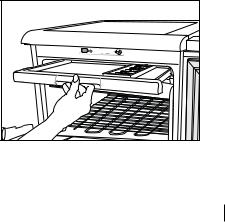
When deep-freezing hot food, the cooling compressor will work until the food is completely frozen. This can temporarily cause excessive cooling of the refrigeration compartment.
If you find the freezer door difficult to open just after you have closed it, don’t worry. This is due to the pressure difference which will equalize and allow the door to open normally after a few minutes.
You will hear a vacuum sound just after closing the door. This is quite normal.
Making ice cubes
Fill the ice-cube tray 3/4 full with water and place it in the freezer.
As soon as the water has turned into ice, you can take out the ice cubes.
Never use sharp objects such as knives or forks to remove the ice cubes. There is a risk of injury!
Let the ice cubes slightly thaw instead, or put the bottom of the tray in hot water for a short moment.
Fast freeze
If large amounts of fresh food are going to be frozen, push the fast freeze switch 24 hours before putting the fresh food in the fast freeze compartment.
It is strongly recommended to keep fast freeze switch on 24 hours to freeze maximum amount of fresh food declared as freezing capacity. Take special care not to mix frozen food and fresh food.
16 EN

Defrosting of the appliance
Excessive build-up of ice will affect the freezing performance of your appliance.
It is therefore recommended that you defrost your appliance at least twice a year, or whenever the ice build-up exceeds 7 mm.
Defrost your appliance when there is only little or no food in it.
Take out the deep-frozen food from the drawers. Wrap the deep-frozen food in several layers of paper, or a blanket, and keep it in a cold place.
Unplug the appliance or switch off the circuit breaker to start the defrosting process.
Take out the accessories (like shelf, drawer etc.) from the appliance and use a suitable container to collect the thawing water.
Use a sponge or a soft cloth to remove thawing water if necessary
Keep the door open during defrosting.
For quicker defrosting, place containers with warm water inside the appliance.
Never use electrical devices, defrosting sprays or pointed or sharpedged objects such as knives or forks to remove the ice.
After the defrosting is done, clean the inside.
Reconnect the appliance to the mains.
Place the frozen food into the drawers and slide the drawers into the freezer.
17 EN

6 Maintenance and cleaning
A Never use gasoline, benzene or similar substances for cleaning purposes.
B We recommend that you unplug the appliance before cleaning.
B Never use any sharp abrasive instrument, soap, household cleaner, detergent and wax polish for cleaning.
CUse lukewarm water to clean the cabinet of your refrigerator and wipe it dry.
CUse a damp cloth wrung out in a solution of one teaspoon of
bicarbonate of soda to one pint of water to clean the interior and wipe it dry.
B Make sure that no water enters the lamp housing and other electrical items.
B If your refrigerator is not going to be used for a long period of time, unplug the power cable, remove all food, clean it and leave the door ajar.
CCheck door seals regularly to ensure they are clean and free from food particles.
A To remove door racks, remove all the contents and then simply push the door rack upwards from the base.
Protection of plastic surfaces
CDo not put the liquid oils or oil-cooked meals in your refrigerator in unsealed containers as they damage the plastic surfaces of your refrigerator. In case of spilling or smearing oil on the plastic surfaces, clean and rinse the relevant part of the surface at once with warm water.
18 EN

7 Recommended solutions for the problems
Please review this list before calling the service. It might save you time and money. This list includes frequent complaints that are not arising from defective workmanship or material usage. Some of the features described here may not exist in your product.
The refrigerator does not operate.
•Is the refrigerator properly plugged in? Insert the plug to the wall socket.
•Is the fuse of the socket which your refrigerator is connected to or the main fuse blown out? Check the fuse.
Condensation on the side wall of the fridge compartment (MULTIZONE, COOL CONTROL and FLEXI ZONE).
•Very cold ambient conditions. Frequent opening and closing of the door. Highly humid ambient conditions. Storage of food containing liquid in open containers. Leaving the door ajar. Switching the thermostat to a colder degree.
•Decreasing the time the door left open or using it less frequently.
•Covering the food stored in open containers with a suitable material.
•Wipe the condensation using a dry cloth and check if it persists.
Compressor is not running
•Protective thermic of the compressor will blow out during sudden power failures or plug-out plug-ins as the refrigerant pressure in the cooling system of the refrigerator has not been balanced yet. Your refrigerator will start running approximately after 6 minutes. Please call the service if the refrigerator does not startup at the end of this period.
•The fridge is in defrost cycle. This is normal for a full-automatically defrosting refrigerator. Defrosting cycle occurs periodically.
•Your refrigerator is not plugged into the socket. Make sure that the plug is properly fit into the socket.
•Are the temperature adjustments correctly made?
•Power might be cut off.
19 EN

The fridge is running frequently or for a long time.
•Your new product may be wider than the previous one. This is quite normal.
Large refrigerators operate for a longer period of time.
•The ambient room temperature may be high. This is quite normal.
•The refrigerator might have been plugged in recently or might have been loaded with food. Cooling down of the refrigerator completely may last for a couple of hours longer.
•Large amounts of hot food might have been put in the refrigerator recently. Hot food causes longer running of the refrigerator until they reach the safe storage temperature.
•Doors might have been opened frequently or left ajar for a long time. The warm air that has entered into the refrigerator causes the refrigerator to run for longer periods. Open the doors less frequently.
•Freezer or fridge compartment door might have been left ajar. Check if the doors are tightly closed.
•The refrigerator is adjusted to a very low temperature. Adjust the refrigerator temperature to a warmer degree and wait until the temperature is achieved.
•Door seal of the fridge or freezer may be soiled, worn out, broken or not properly seated. Clean or replace the seal. Damaged/broken seal causes the refrigerator to run for a longer period of time in order to maintain the current temperature.
Freezer temperature is very low while the fridge temperature is sufficient.
•The freezer temperature is adjusted to a very low temperature. Adjust the freezer temperature to a warmer degree and check.
Fridge temperature is very low while the freezer temperature is sufficient.
•The fridge temperature might have been adjusted to a very low temperature.
Adjust the fridge temperature to a warmer degree and check.
Food kept in the fridge compartment drawers are freezing.
•The fridge temperature might have been adjusted to a very low temperature.
Adjust the fridge temperature to a warmer degree and check.
Temperature in the fridge or freezer is very high.
•The fridge temperature might have been adjusted to a very high degree.
Fridge adjustment has an effect on the temperature of the freezer. Change the temperature of the fridge or freezer until the fridge or freezer temperature reaches to a sufficient level.
•Doors might have been opened frequently or left ajar for a long time; open them less frequently.
•Door might have been left ajar; close the door completely.
•Large amount of hot food might have been put in the refrigerator recently. Wait until the fridge or freezer reaches the desired temperature.
•The refrigerator might have been plugged in recently. Cooling down of the
refrigerator completely takes time. 20 EN
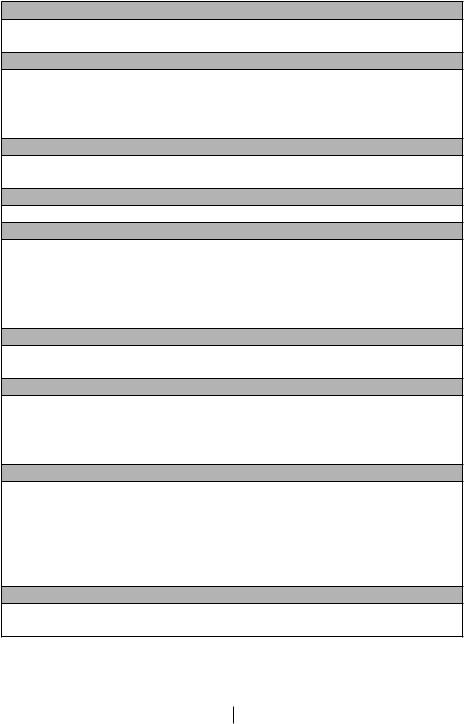
The operation noise increases when the refrigerator is running.
•The operating performance of the refrigerator may change due to the changes in the ambient temperature. It is normal and not a fault.
Vibrations or noise.
•The floor is not even or it is weak. The refrigerator rocks when moved slowly.
Make sure that the floor is strong enough to carry the refrigerator, and level.
•The noise may be caused by the items put onto the refrigerator. Items on top of the refrigerator should be removed.
There are noises coming from the refrigerator like liquid spilling or spraying.
•Liquid and gas flows happen in accordance with the operating principles of your refrigerator. It is normal and not a fault.
There is a noise like wind blowing.
•Fans are used in order to cool the refrigerator. It is normal and not a fault.
Condensation on the inner walls of refrigerator.
•Hot and humid weather increases icing and condensation. It is normal and not a fault.
•Doors might have been left ajar; make sure that the doors are closed fully.
•Doors might have been opened frequently or left ajar for a long time; open them less frequently.
Humidity occurs on the outside of the refrigerator or between the doors.
•There might be humidity in the air; this is quite normal in humid weather. When the humidity is less, condensation will disappear.
Bad odour inside the refrigerator.
•Inside of the refrigerator must be cleaned. Clean the inside of the refrigerator with a sponge, lukewarm water or carbonated water.
•Some containers or package materials might cause the smell. Use a different container or different brand packaging material.
The door is not closing.
•Food packages may prevent the door's closing. Replace the packages that are obstructing the door.
•The refrigerator is not completely upright on the floor and rocking when slightly moved. Adjust the elevation screws.
•The floor is not level or strong. Make sure that the floor is level and capable to carry the refrigerator.
Crispers are stuck.
•The food might be touching the ceiling of the drawer. Rearrange food in the drawer.
21 EN

Bitte lesen Sie zuerst diese Anleitung!
Lieber Kunde,
Wir sind sicher, dass Ihnen dieses Produkt, das in modernsten Fertigungsstätten hergestellt und den strengsten Qualitätsprüfungen unterzogen wurde, lange Zeit gute Dienste leisten wird.
Wir empfehlen Ihnen, vor Inbetriebnahme des Gerätes das gesamte Handbuch durchzulesen und es anschließend aufzubewahren.
Diese Anleitung...
•hilft Ihnen, Ihr Gerät schnell und sicher zu bedienen.
•Lesen Sie die Anleitung, bevor Sie Ihr Gerät aufstellen und bedienen.
•Halten Sie sich an die Anweisungen, beachten Sie insbesondere die Sicherheitshinweise.
•Bewahren Sie die Anleitung an einem leicht zugänglichen Ort auf, damit Sie jederzeit darin nachschlagen können.
•Lesen Sie auch die weiteren Dokumente, die mit Ihrem Produkt geliefert wurden. Bitte beachten Sie, dass diese Anleitung eventuell auch für andere Geräte eingesetzt
werden kann.
Symbole und ihre Bedeutung
In dieser Anleitung finden Sie die folgenden Symbole:
C Wichtige Informationen oder nützliche Tipps.
AWarnung vor Verletzungen oder Sachschäden.
BWarnung vor elektrischem Strom.
Recycling
Dieses Produkt ist mit dem selektiven Entsorgungssymbol für elektrische und elektronische Altgeräte (WEEE) gekennzeichnet.
Das bedeutet, dass dieses Produkt gemäß der europäischen Direktive 2002/96/EC gehandhabt werden muss, um mit nur minimalen umweltspezifischen Auswirkungen recycelt oder zerlegt werden zu können. Weitere Informationen erhalten Sie von Ihren regionalen Behörden.
Elektronikprodukte, die nicht durch den selektiven Entsorgungsvorgang erfasst werden, stellen durch das Vorhandensein potenziell gefährlicher Substanzen umweltund gesundheitsrelevante Risiken dar.

INHALT
1 Ihr Kühlschrank |
3 |
2 Wichtige Hinweise zu Ihrer |
|
Sicherheit |
4 |
Bestimmungsgemäßer Gebrauch....... |
4 |
Bei Geräten mit Wasserspender:........ |
7 |
Kinder – Sicherheit............................. |
7 |
HCA-Warnung.................................... |
7 |
Tipps zum Energiesparen................... |
7 |
3 Installation |
8 |
Was Sie bei einem weiteren Transport |
|
Ihres Kühlschranks beachten müssen.8 |
|
Bevor Sie Ihren Kühlschrank |
|
einschalten......................................... |
8 |
Verpackungsmaterialien entsorgen..... |
9 |
Altgeräte entsorgen............................ |
9 |
Aufstellung und Installation............... |
10 |
Türanschlag umkehren..................... |
11 |
Türanschlag umkehren..................... |
12 |
4 |
Vorbereitung |
13 |
5 |
So bedienen Sie Ihren |
|
Kühlschrank |
14 |
|
LED-Anzeigen und Bedienfeld.......... |
14 |
|
Anzeigeleuchten .............................. |
14 |
|
Einstellen der Betriebstemperatur..... |
15 |
|
6 |
Wartung und Reinigung 18 |
|
Schutz der Kunststoffflächen ........... |
18 |
|
7 |
Empfehlungen zur |
|
Problemlösung |
19 |
|
2 DE
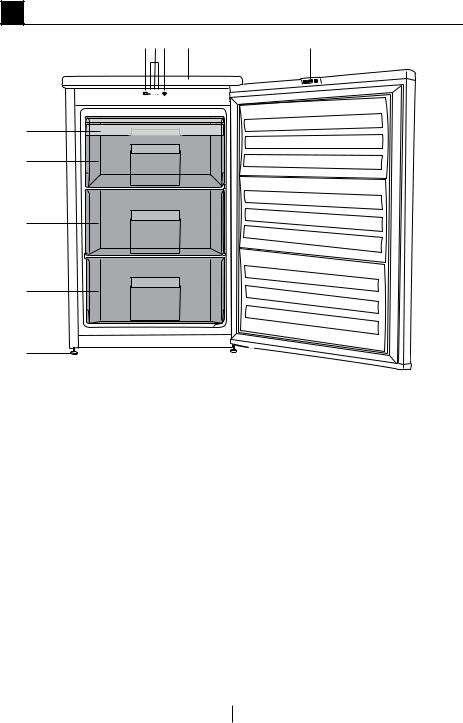
1 Ihr Kühlschrank
3 4 5 |
2 |
1 |
6
7
8
8
9
1.Reflektoren
2.Obere Abschlussplatte
3.Schnellgefrierschalter
4.Anzeigeleuchten
5.Thermostatknopf
6.Eiswürfelfach
7.Schnellgefrierfach
8.Gefriergutfächer
9.Einstellbare Füße an der Frontseite
CAbbildungen und Angaben in dieser Anleitung sind schematisch und können etwas von Ihrem Produkt abweichen. Wenn die Teile nicht im gekauften Produkt enthalten sind, gelten sie für andere Modelle.
3 DE

2 Wichtige Hinweise zu Ihrer Sicherheit
Bitte lesen Sie die folgenden Hinweise aufmerksam durch. Bei Nichtbeachtung kann es zu Verletzungen und
Sachschäden kommen. In diesem Fall erlöschen auch sämtliche Garantieund sonstigen Ansprüche.
Die reguläre Einsatzzeit des von Ihnen erworbenen Gerätes beträgt 10 Jahre. In diesem Zeitraum halten wir Ersatzteile für das Gerät bereit, damit es stets wie gewohnt arbeiten kann.
Bestimmungsgemäßer
Gebrauch
Dieses Produkt ist für folgende
Einsatzzwecke vorgesehen:
–Nutzung in Innenräumen; beispielsweise im Privathaushalt
–Einsatz in Geschäftsräumen; beispielsweise in Geschäften und
Büros
–Verwendung auf Bauernhöfen oder in Beherbergungsbetrieben; beispielsweise in Hotels und Pensionen
•Das Gerät sollte nicht im Freien benutzt werden.
Allgemeine Hinweise zu Ihrer Sicherheit
•Wenn Sie das Gerät entsorgen möchten, wenden Sie sich am besten an den autorisierten Kundendienst.
Hier erhalten Sie notwendige
Informationen und erfahren, welche
Stellen für die Entsorgung zuständig sind.
•Bei Problemen und Fragen zum Gerät wenden Sie sich grundsätzlich an den autorisierten Kundendienst. Ziehen
Sie keine Dritten zu Rate, versuchen 4
Sie nichts in Eigenregie, ohne den autorisierten Kundendienst davon in Kenntnis zu setzen.
•Bei Geräten mit Tiefkühlbereich: Der Verzehr von Speiseeis und Eiswürfeln unmittelbar nach der Entnahme aus dem Tiefkühlbereich ist nicht ratsam. (Dies kann zu Erfrierungen führen.)
•Bei Geräten mit Tiefkühlbereich: Bewahren Sie Getränke in
Flaschen sowie Dosen niemals in Tiefkühlbereich auf. Diese platzen.
•Berühren Sie gefrorene Lebensmittel nicht mit der Hand; sie können festfrieren.
•Ziehen Sie den Netzstecker, bevor Sie den Kühlschrank reinigen oder abtauen.
•Verwenden Sie niemals Dampfoder Sprühreiniger zum Reinigen oder Abtauen Ihres Kühlschranks. Die Dämpfe oder Nebel können in
Kontakt mit stromführenden Teilen geraten und Kurzschlüsse oder
Stromschläge auslösen.
•Missbrauchen Sie niemals Teile Ihres Kühlschranks (z. B. Tür) als Befestigungen oder Kletterhilfen.
•Nutzen Sie keine elektrischen Geräte innerhalb des Kühlschranks.
•Achten Sie darauf, den Kühlkreislauf keinesfalls mit Bohroder Schneidwerkzeugen zu beschädigen.
Das Kühlmittel kann herausspritzen, wenn die Gaskanäle des Verdunsters,
Rohrund Schlauchleitungen oder Oberflächenversiegelungen
DE

beschädigt werden. Dies kann zu Hautreizungen und
Augenverletzungen führen.
•Decken Sie keinerlei Belüftungsöffnungen des
Kühlschranks ab.
•Elektrogeräte dürfen nur von autorisierten Fachkräften repariert werden. Reparaturen durch weniger kompetente Personen können erhebliche Gefährdungen des
Anwenders verursachen.
•Sollten Fehler oder Probleme während der Wartung oder Reparaturarbeiten auftreten, so trennen Sie den Kühlschrank von der Stromversorgung, indem Sie die entsprechende Sicherung abschalten oder den Netzstecker ziehen.
•Ziehen Sie niemals am Netzkabel – fassen Sie stets den Stecker selbst.
•Lagern Sie hochprozentige alkoholische Getränke gut verschlossen und aufrecht.
•Lagern Sie niemals Behälter mit brennbaren Gasen (z. B. Spraydosen) oder explosive Dinge im Kühlschrank.
•Nutzen Sie keine mechanischen oder andere Hilfsmittel, um das Gerät abzutauen – es sei denn, solche Hilfsmittel werden ausdrücklich vom Hersteller empfohlenen.
•Dieses Gerät darf nicht von Personen
(einschließlich Kindern) benutzt werden, die unter körperlichen oder geistigen Einschränkungen leiden oder denen es an der nötigen Erfahrung im Umgang mit solchen
Geräten mangelt. Eine Ausnahme kann gemacht werden, wenn solche Personen ständig beaufsichtigt
werden und/oder gründlich in der Verwendung des Gerätes unterwiesen wurden.
•Nehmen Sie einen beschädigten Kühlschrank nicht in Betrieb. Wenden Sie sich im Zweifelsfall unbedingt zuerst an den Kundendienst.
•Die elektrische Sicherheit des Gerätes ist nur dann gewährleistet, wenn das hausinterne Erdungssystem den zutreffenden Normen entspricht.
•Setzen Sie das Gerät keinem Regen, Schnee, direktem Sonnenlicht oder
Wind aus, da dies die elektrische
Sicherheit gefährden kann.
•Damit es nicht zu Gefährdungen kommt, lassen Sie beschädigte Netzkabel unverzüglich vom
Kundendienst austauschen.
•Stecken Sie während der Installation niemals den Netzstecker ein. Andernfalls kann es zu schweren bis tödlichen Verletzungen kommen.
•Der Kühlschrank darf nur zum Lagern von Lebensmitteln, keinesfalls für andere Zwecke verwendet werden.
•Das Typenschild mit technischen
Daten befindet sich an der linken Innenwand des Kühlschranks.
•Schließen Sie den Kühlschrank niemals an Energiesparsysteme an; andernfalls kann es zu Beschädigungen kommen.
•Bei Geräten mit blauer Innenbeleuchtung: Schauen Sie
5 DE
